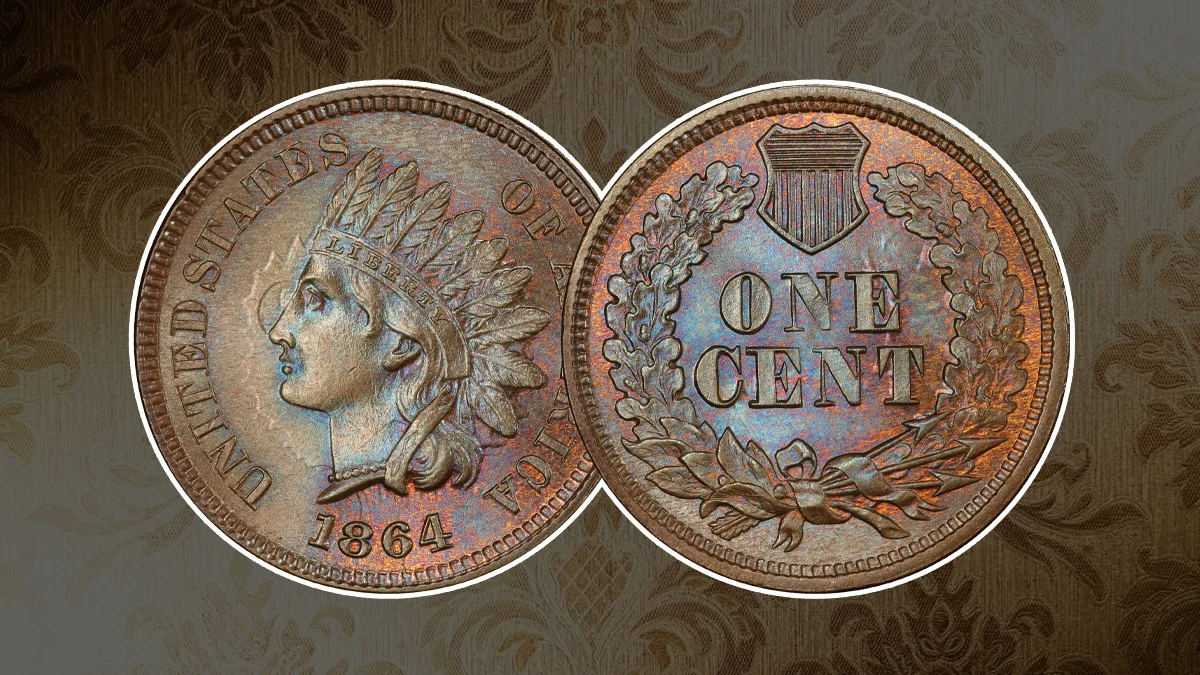
The 1864 Indian Head Penny is a unique coin of American numismatic history, capturing a unique moment in time with its fascinating variations and historical value. This coin describes a pivotal year in the series, presenting collectors with a glimpse into the economic and technological changes of the Civil War era. The 1864 Indian Head Penny has a unique place in the hearts of coin lovers because of copper-nickel and bronze designs, along with a unique design transformation,
History of 1864 Indian Head Penny
James B. Longacre designed the Indian Head Penny series, which was introduced in 1859 and took the place of the Flying Eagle Cent. Because of its unique design, which mixed American symbolism with elements of classical beauty, the series immediately obtained popularity. The Indian Head Penny’s 1864 introduction was particularly important since it represents the change from the original copper-nickel composition to a lighter, easier-to-find bronze composition.
The Civil War’s financial impacts were what triggered this transformation. Since the coin’s development, copper-nickel combinations have been used, but they have become more expensive and more difficult to find. The U.S. Mint responded by choosing to switch to a bronze alloy, which is made up of 5% tin and zinc and 95% copper. This allowed to meet the growing need for small-denomination coinage during the war by reducing manufacturing expenses and allowing the minting of more coins.
A small but remarkable change to the design was also made on the penny in 1864. In a discrete honor to the designer’s last name, Longacre placed an “L” to the ribbon on Lady Liberty’s headpiece on some of the bronze pennies. The change was designed to set the new bronze pennies away from their copper-nickel predecessors, and as a result, collectors valued the 1864 “L” type of coin.
Specifications
- Year of Issue: 1864
- Mint Mark: None (Philadelphia Mint)
- Composition: Copper-Nickel (first part of the year), Bronze (later part of the year)
- Weight: 4.67 grams (Copper-Nickel), 3.11 grams (Bronze)
- Diameter: 19 mm
- Edge: Smooth
- Mintage: 39,233,000
Design
Obverse:
The obverse side of the 1864 Indian Head Penny shows a profile of Lady Liberty, adorned with a Native American headdress. This design is related to a powerful symbol of unity, describing both the classical roots of Western civilization and the emerging identity of the American nation. The inscription “UNITED STATES OF AMERICA” surrounds the portrait, with the date “1864” prominently shown at the bottom. On some of the bronze pennies, the ribbon in Lady Liberty’s hair carries a small “L,” with an extra layer of intrigue and value to the coin.
Reverse:
The reverse side is equally striking, and shows a simple ultimately elegant oak wreath. The wreath surrounds the denomination “ONE CENT,” which is shown on the coin center. At the top of the coin of the wreath is a shield, representing strength and stability—qualities that were especially rich during the Civil War. The reverse design, with its focus on agricultural motifs, reflects the rural basis of the American economy at the time.
Types of 1864 Indian Head Penny
The 1864 Indian Head Penny has two main types with its unique characteristics and appeal:
- Copper-Nickel Version: The copper-nickel version of the 1864 penny is made with 88% copper and 12% nickel. It is heavier and has a little lighter color like the bronze version. This type was minted earlier in the year and is less familiar than the bronze version.
- Bronze Version: The bronze version, was presented last in 1864. It is made with 95% copper and 5% tin and zinc. It is lighter in weight and darker in color which makes it easily different from the copper-nickel version. The bronze penny can also be seen with or without the “L” on the ribbon, with the “L” variant being especially prized by collectors.
Rarity and Condition
The rarity of the 1864 Indian Head Penny depends on the type and condition of the coin. The bronze version with the “L” on the ribbon is quite rare. Coins are more common and commonly have lower values in average circulated conditions. However, pennies in mint condition with the “L” marking, are much rarer and can command high prices at auction.
Collectors evaluate the value of an 1864 Indian Head Penny depending on several factors which are the coin’s overall condition, the presence of the “L” on the ribbon, and any unique characteristics such as errors or die variations.
Errors
The 1864 Indian Head Penny are not quite common, they do exist and can add significant value to the coin. Some of the errors are:
- Off-Center Strikes: These happen when the coin is not properly aligned in the minting process, resulting in it being shifted off-center.
- Die Cracks: These types of errors are lines or fissures that appear on the coin’s surface because of a cracked die. Die cracks can make unique and desirable patterns on the coin.
- Variations in the “L” Placement: The “L” on the ribbon may be just misaligned or less famous on some bronze pennies. These errors can raise the coin’s value.
Value of 1864 Indian Head Penny
The value of the 1864 Indian Head Penny is based on its type, condition, and unique characteristics. The coin is valued at around $10 in average circulated conditions. However, coins in mint state can be worth quite more, with prices as high as $650 or more at auction. The bronze version with the “L” on the ribbon is valuable, fetching four times the price of a similar coin without the “L.”
Also Read – 1856 Flying Eagle Cent: A Comlete Guide
Conclusion
The 1864 Indian Head Penny is a famous coin. It provides collectors with a rich blend of history, design, and numismatic value. Its unique composition, design variations, and the historical value of its production make it a must-have for any serious coin lover. If you have a copper-nickel or bronze version, or you’re on the search for the unavailable “L” variant, the 1864 Indian Head Penny is a coin that promises to enhance any collection.
